The nice thing about a conference is that there is a lot to see and do. The bad thing about a conference is there is a lot to see and do.
Overall, I have a really good feeling leaving this event. In my mind, I had placed a lot of importance on how well my photos were received with the portfolio reviews. I've worked hard the last two years to improve the quality of my work as a nature photographer. It was very important to me that my work be at a professional level. With one exception, the reviewers seemed pleased with my work. I have several opportunities as a result of attending. I am very pleased and grateful to have reached this point. Now it is my job to follow up on these opportunities. And I hope and pray that God will bless my work.
I've gotten a little behind in my blogging, but there are some other things I want to share. We moved from the Hyatt today - and you should have seen the bell men loading up all our belongings. Because I had not finished my portfolio, we had brought the printer and its big box as well as all our clothes, computers, camera equipment, etc. I was pleasantly surprised that I was able to get everything repackaged as quickly as I did. I also had photos that I wanted to get in the mail to a magazine editor . . . so those needed to be printed before we left. There is much that I am hoping I don't have to remove from the car again until we get home.
I have packed some of the information that I want to blog - such as things that I learned from the Color Management session.
So for those of you that are reading my blog for photo information, please keep checking in. I do plan to do several more blogs about the conference. There is still much to share . . . . .
Monday, February 13, 2006
The Raptor Field Trip

One of the special events at this NANPA was a visit to Fort Collins to visit the raptors that are part of the Rocky Mountain Raptor Program. This program nurses injured birds back to health and provides programs for education. We got to see and photograph six birds - an American kestral, a swainson hawk, a golden eagle, a great horned owl, a long eared owl, and a burrowing owl. The volunteers were especially good at placing the birds so that we had natural backgrounds for our photos.
Yes, these are captive birds, but they have all been injured or damaged in some way, and probably would not survive in the wild. The burrowing owl had lost one eye - they don't know how but suspect he got hit by a car. One of my positions on captive animals is that they act as good will ambassadors for their species. By educating our children as to the beauty, magesty, and purpose of these animals, they will learn to appreciate nature and hopefully gain the desire to preserve our natural resources.
When I have attended various sessions such as this, it helps me better identify the birds in the wild. I also appreciate the beauty of their feather patterns and their keen intelligence. It is truly a joy and a privilege to spend time with these incredible birds of prey.
Friday, February 10, 2006
Personal Reflections on today
While I learned a lot at the Keynote and the Breakout Sessions - today had its own anxieties. I am doing portfolio reviews to learn how to improve my work, to see how my work measures up, and with the hopes of eventually getting my work published. I had two reviews today. I was very pleased that the Nature's Best editor liked my work. I will be entering two contests this year - one that I learned about today. I was not too surprised that the Corbis editor was not as interested in my work. It is hard to compete with Arthur Morris' bird photography and Darrel Gulin's flowers.
I also showed ten of my Death Valley Flowers at the Member Slideshow. It is good experience for me to participate and show my work before this audience (a friendly one I might add). If you are lucky enough to get to participate, you get to show 10 slides and give a three and one half minute talk. Those of you that know me, know that I am "long winded" at times. So the time limit gives me an anxiety I might not have in other situations. Plus, as I hear the other presentations, my mind tends to make adjustments - not always for the best.
Another note, I have two images that made the NANPA Impressions journal. So this is my first real publication credit. It was fun and gratifying today to see my own work in a publication.
A start in the right direction, at least.
I also showed ten of my Death Valley Flowers at the Member Slideshow. It is good experience for me to participate and show my work before this audience (a friendly one I might add). If you are lucky enough to get to participate, you get to show 10 slides and give a three and one half minute talk. Those of you that know me, know that I am "long winded" at times. So the time limit gives me an anxiety I might not have in other situations. Plus, as I hear the other presentations, my mind tends to make adjustments - not always for the best.
Another note, I have two images that made the NANPA Impressions journal. So this is my first real publication credit. It was fun and gratifying today to see my own work in a publication.
A start in the right direction, at least.
Jack Dykinga - Where does it come from?
Jack Dykinga gave the morning keynote speech. His desert photography is truly amazing as he finds such wonderful morning lighting and creates photos from agave and saguaro with such wonderful use of form, line, and pattern. His speech and photos really spoke to some ways that I have approached photography. I really liked his concept of "living with the subject", returning over and over to the same area to find not only the "right" lighting, but also the variety of light, clouds, atmosphere, and weather to create beautiful visions for us to enjoy. In so many of the online critiques I have received over time, people keep wanting detail in the shadows - but he used black shadows and silhouettes as part of his planned canvas. He also used black shadows to create diagonal lines and to provide symbolism. When he found a great compositions, he would return and take the same shot under different conditions. Another strategy he used that I can identify with - was to thoroughly explore your area - he mentioned hiking in concentric circles - finding the soul and essence of a place.
So I left inspired to continue going back to my favorite places, with the hopes that with frequent visits I will find the magic combination of lighting and atmosphere to create my own "magic".
So I left inspired to continue going back to my favorite places, with the hopes that with frequent visits I will find the magic combination of lighting and atmosphere to create my own "magic".
Thursday, February 09, 2006
John Fielder and the Roxborough State Park Field Trip
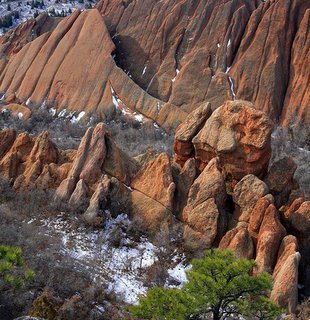
When I became serious about doing something with my photography, one of the first books I picked up was John Fielder's Photographing the Landscape - The Art of Seeing
On Wednesday, I chose his workshop because of the concept of photographing the "intimate landscape." It sounded like an interesting location - one I had not visited. John gave us a workshop and slideshow presentation before we did our hike around the park. It refreshed my memory of all the concepts I remembered from the book. He personally led us through Roxborough State Park. He and his assistant took time to look through our viewfinders to help us improve our compositions, as well as making suggestions to help us "see" those lines and shapes to make our shots more satisfactory.
John also gave the keynote speech this afternoon. I am very impressed with how he has combined his marketing background, his photography skills, and his genuine concern for the well being of the environment in Colorado. He brings a keen analytical mind to find solutions for some of the environmental issues facing our country today - and has shown a creativity in finding workable solutions. '
I would thoroughly recommend doing any of John Fielder workshops, because I think you would learn a lot and come away very inspired to create your vision of your world.
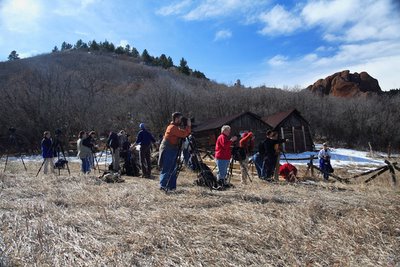
Wednesday, February 08, 2006
Macro Photography Workshop

My first workshop was with Nancy Rotenberg . I chose this workshop because I am fascinated with flowers and flower photography and I really wanted to improve my skills. This workshop provided all of that and more. Just walking into the room the first time was a delight. I had mentioned to Henry that if I was doing this workshop, I would have all sorts of flowers to work with. At the entrance to the room was a series of tables, all with something interesting and beautiful to photograph. She had background choices, flower choices, lighting, frosted and sculpted glass, water drop setups, all beautifully arranged. When she began, I was struck by her affirmation for each of us - her "can do" attitude. Of course, she also greeted each one of us warmly before the session even started. I have noticed among the photographers their worldview tends to be infinite rather than finite. There is room for each of us to be the individuals that we are. She stressed that each of us has an artist and poet within. I loved the book she chose: The Dot
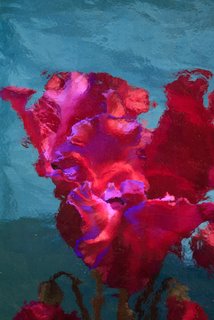
I really enjoyed the opportunity to try out different techniques that I had read and heard about, but that I had not constructed the setups for. We had all afternoon to play. She and her 3 assistants went around helping us without getting in our way.
As far as equipment ideas:
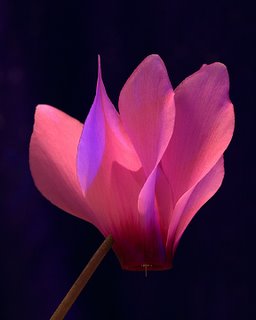
The flashlights that had different colored lights were really fun to play with - I've found a likely candidate at REI.
I want to get the Canon 500D - a closeup lens to fit over my 180mm macro for even closer shots.
The Plamp I've signed up in the silent auction for one of these.
All sorts of frosted and cut glass - I'll see if Henry can help me make stands for these.
Wimberly's Flash brackets - Macro Bracket-to adjust the angle for my flash (although I wasn't pleased with my use of flash at the workshop.)
Tuesday, February 07, 2006
North American Nature Photographers Association Summit
Today was the first day . . . . . I went to the Macro and Creativity Workshop . . . . . Look for more details tomorrow - it was WONDERFUL!!!!!!!
Saturday, February 04, 2006
Winter Solitude
We left Breckenridge on Wednesday. After staying five weeks at the condo, there was much to pack up and load back into the car. And a doctor's call sent me to his office to get my shoulder checked before we could leave - one more thing to slow us down. But we did get off - and headed toward the western side of Rocky Mountain National Park. Instead of taking the fast paced, stressful I-70, we headed north out of Frisco and went through Kremling - leaving the populated areas of Dillon, Silverthorne, Frisco, and Breckenridge behind. It was snowing on our first pass through Rocky Mountain National Park. The highest peaks were hiding behind snow clouds. As we headed out of the park, we passed an area where the snowmobile trail paralleled the road complete with snowmobilers sharing the road with us. We found a hotel in Grand Lake Village - a small rustic town. I almost think that at this time of year the snowmobiles outnumber the cars - as there were snowmobiles to rent EVERYWHERE. It turns out there is a large trail system in the national forest just north of town. You could probably spend days exploring all of them. Grand Lake is obviously doing well financially based upon the well kept building and upscale souvenir shots, but this is not their big season. Our first search for restaurants found many of them "closed." We settled for the restaurant across the street from our hotel, Bear's Den & Paws Pub. The trout almondine was good and we ate there a couple of times during our stay.
It was snowing when we went to bed, and I was looking forward to getting out at dawn, hoping for a colorful mountain sunrise. We got out early and were the first ones to make tracks on the snow in the park - that is, the first human tracks . . . . . Over the next few days we had a lot of fun studying the animal tracks in the snow. The west side of the park gets much more snow and moisture than the eastern side. As a result, the snows are deeper in the winter, and many of the parks animal residents either hibernate or move down below to winter. Birds were few and far between - I think I saw only three or four during the days we were there. Our most common animal siting were the moose that frequented the road.

However, there were lots of animal tracks. Snowshoe hare was the most common,

followed by the moose that crashed through the snowberms along the road.
But we also saw some smaller tracks that were harder for us to identify.
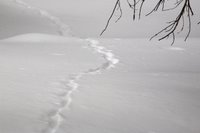 We saw one series that were most likely coyote, complete with a trail "marker".
We saw one series that were most likely coyote, complete with a trail "marker".
We saw tracks that were probably weasels and squirrels. I decided that it would be fun to photograph the tracks perhaps to identify later.
While there were a few people driving through, snowshoeing, or cross country skiing, Henry and I pretty much had the park to ourselves. We could hear the wind whistling through the trees, watch the snow devils across the frozen beaver swamps, and enjoy the falling snow.
It was snowing when we went to bed, and I was looking forward to getting out at dawn, hoping for a colorful mountain sunrise. We got out early and were the first ones to make tracks on the snow in the park - that is, the first human tracks . . . . . Over the next few days we had a lot of fun studying the animal tracks in the snow. The west side of the park gets much more snow and moisture than the eastern side. As a result, the snows are deeper in the winter, and many of the parks animal residents either hibernate or move down below to winter. Birds were few and far between - I think I saw only three or four during the days we were there. Our most common animal siting were the moose that frequented the road.

However, there were lots of animal tracks. Snowshoe hare was the most common,

followed by the moose that crashed through the snowberms along the road.
But we also saw some smaller tracks that were harder for us to identify.
 We saw one series that were most likely coyote, complete with a trail "marker".
We saw one series that were most likely coyote, complete with a trail "marker". We saw tracks that were probably weasels and squirrels. I decided that it would be fun to photograph the tracks perhaps to identify later.
While there were a few people driving through, snowshoeing, or cross country skiing, Henry and I pretty much had the park to ourselves. We could hear the wind whistling through the trees, watch the snow devils across the frozen beaver swamps, and enjoy the falling snow.
Labels:
Photography,
Rocky Mountain National Park,
WIldlife,
Winter
Subscribe to:
Posts (Atom)

